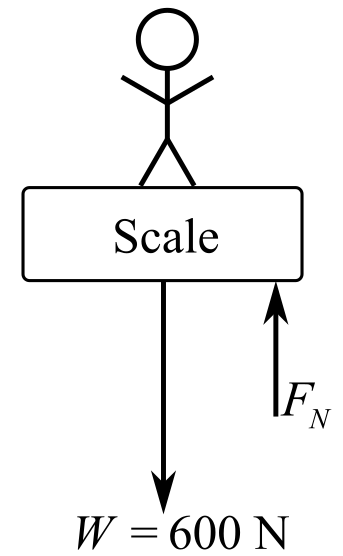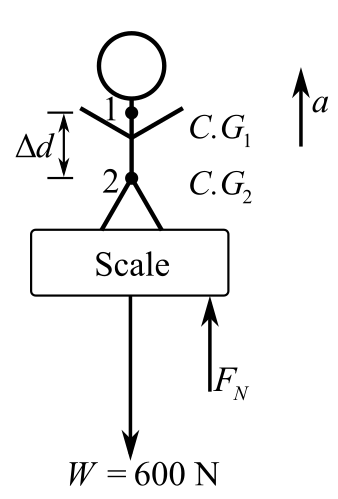
Concept explainers
A person stands on a scale, which then reads 600 N. (a) What force is exerted on the scale by the person? (b) What force is exerted on the person by the scale? (c) What would happen to the reading as the person began to jump straight up?
(a)
The magnitude of the force applied on the scale by the person if he stands on a scaleand the readingis
Answer to Problem 9SP
Solution:
Explanation of Solution
Given data:
The weight of the person is
The scale is at rest, so there will be no acceleration.
Formula used:
Write the expression for the first condition of force equilibrium:
Here,
Explanation:
Draw the free body diagram of the scale when the person stands on it:

In the diagram,
Recall the expression for the first condition of force equilibrium:
Consider that the direction of the upward forces is positive and the direction of the downward forces is negative. Therefore,
Substitute
From Newton’s third law, the force exerted on the scale by a person is equal and opposite to the weight of the person and it acts in the downward direction because the force applied by the person is in the downward direction. So, the magnitude of force applied by the person to the scale should be equal to the normal reaction force applied by the contact surface of the scale to the person.
Conclusion:
The magnitude of the force applied on the scale by the person is
(b)
The magnitude of the force applied on the person by the scale if he stands on a scale and the scale reads
Answer to Problem 9SP
Solution:
Explanation of Solution
Given data:
The weight of the person is
The scale is at rest, so there will be no acceleration.
Formula used:
Write the expression for the first condition of force equilibrium:
Here,
Explanation:
Draw the free body diagram of the scale:

In the above diagram,
Recall the expression for the first condition of force equilibrium:
Consider that the direction of the upward forces is positive and the direction of the downward forces is negative. Therefore,
Substitute
From Newton’sthird law, the force exerted on the person by the scale is equal and opposite to the weight of the person and it actsin the upward direction because the force exerted by the scale is in the upward direction.
Conclusion:
Therefore, the magnitude of the force applied on the person by the scale is
(c)
The reading on a scale when the person begins to jump straight up on a scale.
Answer to Problem 9SP
Solution:
Increase
Explanation of Solution
Given data:
The weight of the person is
The scale is at rest, so there will be no acceleration.
Formula used:
Write the expression for Newton’s second law of motion:
Here,
Explanation:
Draw the free body diagram of the person when he begins to jump:

In the diagram given above,
Recall the expression for Newton’s second law of motion along the vertical direction:
Consider that the direction of the upward forces is positive and the direction of the downward forces is negative. Therefore,
Here,
Conclusion:
Therefore, as the person starts to jump straight up, the reading of the scale would increase.
Want to see more full solutions like this?
Chapter 4 Solutions
Schaum's Outline of College Physics, Twelfth Edition (Schaum's Outlines)
- For the woman being pulled forward on the toboggan in Figure 4.33, is the magnitude of the normal force exerted by the ground on the toboggan (a) equal to the total weight of the woman plus the toboggan, (b) greater than the total weight, (c) less than the total weight, or (d) possibly greater than or less than the total weight, depending on the size of the weight relative to the tension in the rope?arrow_forwardA crate remains stationary after it has been placed on a ramp inclined at an angle with the horizontal. Which of the following statements must be true about the magnitude of the frictional force that acts on the crate? (a) It is larger than the weight of the crate. (b) It is at least equal to the weight of the crate. (c) It is equal to sn. (d) It is greater than the component of the gravitational force acting down the ramp. (e) It is equal to the component of the gravitational force acting down the ramp.arrow_forwardA 3.00-kg object is moving in a plane, with its x and y coordinates given by x = 5t2 1 and y = 3t3 + 2, where x and y are in meters and t is in seconds. Find the magnitude of the net force acting on this object at t = 2.00 s.arrow_forward
- A black widow spider hangs motionless from a web that extends vertically from the ceiling above. If the spider has a mass of 1.5 g, what is the tension in the web?arrow_forwardWhich of the following statements are true? (a) An object can move even when no force acts on it. (b) If an object isn't moving, no external forces act on it. (c) If a single force acts on an object, the object accelerates. (d) If an object accelerates, at least one force is acting on it. (e) If an object isn't accelerating, no external force is acting on it. (f) If the net force acting on an object is in the positive x-direction, the object moves only in the positive x-direction.arrow_forwardA 12 N horizontal force F pushes a block weighing 5.3 N against a vertical wall (see the figure). The coefficient of static friction between the wall and the block is 0.61, and the coefficient of kinetic friction is 0.48. Assume that the block is not moving initially. (a) Will the block move? ("yes" or "no") |(b) In unit-vector notation what is the force on the block from the wall?arrow_forward
- Three forces act on an object. A 3-N force acts due west and a 4-B force acts due south. If the netforce on the object is zero, what is the magnitude of the third force?arrow_forwardTwo boxes, A and B, are at rest. Box A is on level ground, while box B rests on an inclined plane tilted at angle θ with the horizontal. (a) Write expressions for the normal force acting on each block. (b) Compare the two forces; that is, tell which one is larger or whether they are equal in magnitude. (c) If the angle of incline is 10° , which force is greater?arrow_forwardA 15.0-lb block rests on a horizontal floor. (a) What force does the floor exert on the block? (b) A rope is tied to the block and is run vertically over a pulley. The other end is attached to a free-hanging 10.0-lb object. What now is the force exerted by the floor on the 15.0-lb block? (c) If the 10.0-lb object in part (b) is replaced with a 20.0-lb object, what is the force exerted by the floor on the 15.0-lb block?arrow_forward
- When a 100 N bag of nails hangs motionless from a single vertical strand of rope, how many newtons of tension are exerted in the strand? What if the bag is supported by four vertical strands?arrow_forwardOn her way to visit Grandmother, Red Riding Hood sat down to rest and placed her 1.20-kg basket of goodies beside her. A wolf came along, spotted the basket, and began to pull on the handle with a force of 6.40 N at an angle of 25° with respect to vertical. Red was not going to let go easily, so she pulled on the handle with a force of 13.5 N. If the net force on the basket is straight up, at what angle was Red Riding Hood pulling from the vertical? The whole question did not paste in on my last attempt.arrow_forwardOn her way to visit Grandmother, Red Riding Hood sat down to rest and placed her 1.20-kg basket of goodies beside her. A wolf came along, spotted the basket, and began to pull on the handle with a force of 6.40 N at an angle of 25° with respect to vertical. Red was not going to let go easily, so she pulled on the handle with a force of 13.5 N. If the net force on the basket is straight up, at what angle was Red Riding Hood pulling from the vertical? I was given the WRONG answer this morning! The force that Red applied was 13.5N NOT 12.2 N! Use 13.5 N! I use this service primarily to check my work. If the "experts" are using the wrong values, I question if they will use the right mathematical procedures if I really have a challenge!arrow_forward
 College PhysicsPhysicsISBN:9781285737027Author:Raymond A. Serway, Chris VuillePublisher:Cengage Learning
College PhysicsPhysicsISBN:9781285737027Author:Raymond A. Serway, Chris VuillePublisher:Cengage Learning College PhysicsPhysicsISBN:9781305952300Author:Raymond A. Serway, Chris VuillePublisher:Cengage Learning
College PhysicsPhysicsISBN:9781305952300Author:Raymond A. Serway, Chris VuillePublisher:Cengage Learning Principles of Physics: A Calculus-Based TextPhysicsISBN:9781133104261Author:Raymond A. Serway, John W. JewettPublisher:Cengage Learning
Principles of Physics: A Calculus-Based TextPhysicsISBN:9781133104261Author:Raymond A. Serway, John W. JewettPublisher:Cengage Learning Physics for Scientists and Engineers: Foundations...PhysicsISBN:9781133939146Author:Katz, Debora M.Publisher:Cengage Learning
Physics for Scientists and Engineers: Foundations...PhysicsISBN:9781133939146Author:Katz, Debora M.Publisher:Cengage Learning



